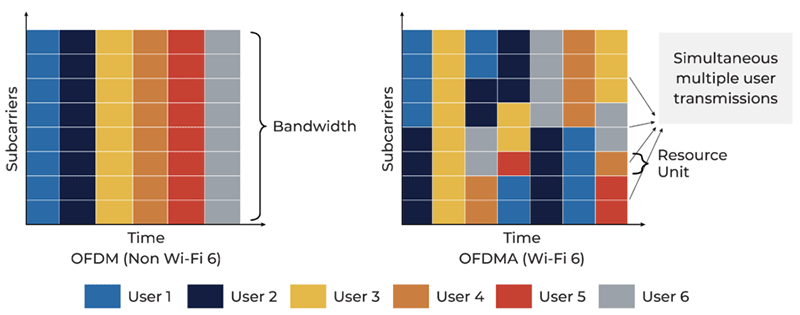The consumer Wi-Fi market is poised for another giant leap in performance with 802.11ax, better known as Wi-Fi 6. The Wi-Fi Alliance has chosen to replace the cryptic "802.11" nomenclature with number designations to reduce consumer confusion and speed adoption. History has shown that the dominance of existing Wi-Fi 5 (previously referred to as 802.11ac) devices and Access Points (APs) will inevitably be replaced by Wi-Fi 6, just as they replaced Wi-Fi 4 (802.11n). The timing of this transition dovetails with the proliferation of multi-gigabit networks and terrestrial 5G network rollouts. The benefits to consumers go beyond just speed, and this blog offers four such benefits for your consideration.
Greater Bandwidth
Bandwidth is always the first thing that comes to mind with any new communications standard, and Wi-Fi 6 definitely delivers. The physics of wireless communications dictates that the greater the spectrum and the wider the channel, the more bandwidth you can deliver. This is true for Wi-Fi just as it is for terrestrial microwave and cellular networks. That is why the expansion from dual-band (2.4+5GHz) operation to tri-band (2.4+5+6GHz) operation (6E effectively includes the spectrum from 5.925GHz - 7.125GHz) is so significant; coupled with the effective doubling of available channels across these bands, will enable more IoT devices to connect across a wider range of channels.

Resilience to Congestion
Another big advantage of Wi-Fi 6 is its ability to handle dense, noisy RF environments. The traffic congestion that has long been a problem in places like hotels, airports and sports stadiums is now coming to the home with the proliferation of personal tablets/phones and over-the-top (OTT) streaming devices. Wi-Fi 6 manages this increase in traffic with a combination of technology advancements. First, it uses multiple antennas to communicate with multiple devices at a time; this is called Multi-User Multiple-Input/Multiple-Output (MU-MIMO). Additionally, Orthogonal Frequency Division Multiple Access (OFDMA) allows a wireless channel to be divided into multiple sub-channels, with each of those sub-channels carrying data for a separate device. This enables reduced protocol overhead and increased efficiency that will support increased IoT device proliferation. This, coupled with Basic Service Set (BSS) Coloring, dramatically increases network capacity and efficiency in congested areas through a form of spatial diversity.

Reduced Power Consumption Using TWT
In an IoT world, reduced power consumption is key to increasing battery life. A Wi-Fi 6 feature called Target Wait Time (TWT) facilitates this by telling the device when to put its Wi-Fi radio to sleep and when to wake up to receive the next transmission. This technique can extend the battery life of low-power devices from months to years.
Reduced Latency
Reduced latency is one of those hidden benefits that Wi-Fi 6 will now have in common with mobile 5G deployments. There was a time when wireless networks routinely lost the latency battle to wireline networks. That time has come to an end with latency values reduced over an order of magnitude from as much as 100ms to less than 10ms. This is especially important for applications like connected autonomous vehicles (CAV) and virtual reality (VR), where real-time data is critical to system performance.
Wi-Fi 6 is coming soon to a device near you!
IoT applications alone will drive Wi-Fi 6/6E deployments to eclipse all previous versions by 2024, but many IoT applications and use cases require high-throughput and low-latency wireless communication capabilities like Virtual Reality and industrial control systems and they will benefit significantly. In addition, Wi-Fi 6E will be a prime candidate for 5G cellular off-load when available. Read more about Wi-Fi 6/6E, and request early samples of Renesas' Wi-Fi 6 silicon.
